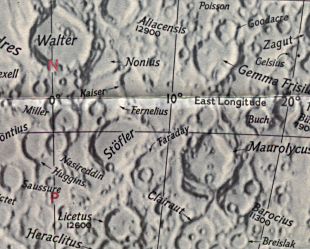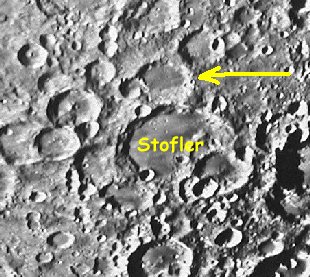

from Dave Mitsky
At approximately 07:00 UT (2004/1/14) I noted what may have been a sunset lunar ray in the crater Fernelius using the 17" f/15 classical Cassegrain at the ASH Naylor Observatory. I employed magnifications of 162, 231, and 259x.
Although it was quite cold and windy and the seeing was rather poor, I could see a very thin shaft of light at approximately 5 degrees east, 38 degrees south. There was an illuminated wedge to the immediate south and another one in the adjoining crater Stoefler but I don't believe that either one of these were rays.
There is an image of Fernelius athttp://www.rccr.cremona.it/monografie/luna/idkt220.htm
Dave Mitsky
Site Longitude = +75.880
Site Latitude = +40.150
Reproducing Lighting For: 2004/1/14 at 07:00 U.T.
Desired Solar Altitude = +1.718(Setting), Azimuth = +269.567
Feature = FERNELIUS
Feature Longitude: = +4.900
Feature Latitude: = -38.100
Average Co-longitude = 172.916
Moon's Altitude Restricted = N
In the Time column, D=Daylight, T=Twilight
---- Moon's ---- -- Earth's --
Topocentric Topocentric -------- Sun's --------
UT Date Time Alt° Semi-Diam'' Long° Lat° Colong° Lat° Azim°
2004/01/14 07:00 +27.997 959.03 -4.791 -3.474 174.015 -1.401 +269.567
Fernelius +068, -617: A walled plain 40 miles in diameter. It lies closely north-east of Stofler, and is dwarfed by that great and important object. The floor is fairly level, though it does contain a number of small craterlets. To the east of Fernelius is an imperfect formation, A, 17 miles in diameter; this lacks part of its western wall, so that the interior is joined to that of Fernelius. (Wilkins & Moore, The Moon, 1955, Faber & Faber Ltd)

